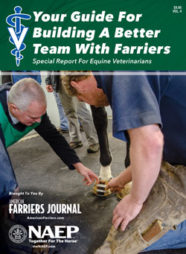Whether you’re injured on the job, planning a vacation or recovering from surgery, there will come a time when you need to be away from your practice for an extended period. Having a plan in place for such an absence will save you the headache of finding coverage for your horses, loss of income and potentially losing clients.
Develop A Plan
In 2010, Point Pleasant, N.J., farrier Mike Heinrich and his wife Taryn came up with a detailed system about 6 months before Mike’s scheduled bilateral knee replacement. The couple created a spreadsheet (see example below) that included vital information about the horses on Mike’s books.
“The spreadsheet was made with the ‘replacement farrier’ in mind,” Taryn says. “We gave copies to the farriers who would be working on Mike’s horses. We wanted them to know a little about the horses — what shoes they wore, any physical or behavioral issues, client information, when the horses were last done and when they were due, etc.”
Using area farriers, the couple coordinated which farrier would do which horses ahead of time, based on the farrier’s knowledge (for specialty or therapeutic cases), the amount of horses each guy could take on and the location the farriers generally worked. If Mike had a horse that wore shoes not normally stocked by the replacement farrier, he provided them or left them with clients.
“We set up this whole spreadsheet in a weekend. Once we figured out what to include, we just went through the last 8 weeks of Mike’s appointment book and input the information for each horse,” says Taryn.
Keep Clients In The Loop
Mike’s clients were informed about his upcoming absence several months ahead of time. They were told why Mike would be out of work and who would be taking his place with their horses.
Have a plan in place for your absence to save you from losing income and clients.
Let clients know ahead of time why you will be out of work and who will be taking care of their horses.
A spreadsheet that includes information about all the horses on your books is helpful should you need another farrier to temporarily take over.
“Initially some clients were leery, but by informing them early, they had the opportunity and time to ask questions. We provided each one with a letter detailing who would be working on their horses and that farrier’s contact information,” she says. “About 95% of clients were OK with everything and had no issues whatsoever. They really liked that their replacement farrier knew a little about their horses and didn’t have to be told things like, ‘my guy with the bad hocks needs his hind feet held low.’”

New Jersey farrier Mike Heinrich and his wife Taryn developed a spreadsheet to help keep his practice running smoothly during a long-term absence.
Can Your Business Sustain A Long-Term Absence?
If you’re hurt by a horse, in an accident or diagnosed with a serious illness, what will happen to your business? Being prepared can mean the difference between keeping your business afloat and retaining clients or losing everything and having to start over.
While Mike Heinrich’s absence was planned, many are not. Heinrich’s spreadsheet — or something like it — can come in handy in such cases.
When a farrier becomes ill or injured, other shoers often come together and look for ways to help their colleague. Many times they will take over the care of your horses until you’re back on your feet. Having information on all of your clients and their horses in one place can save a lot of time and stress if other farriers need to step in and help.
Farrier Associations
Associations such as the American Association of Professional Farriers (AAPF), the American Farrier’s Association (AFA) and your local farrier association can provide guidance to you or your family should you be unable to work.
In fact, the AAPF has its own Farrier Assistance Committee whose mission is to implement a program to provide assistance to ill or injured members.
Associations are also great resources for putting you in contact with other farriers in your area. Having a core group of farrier colleagues that you know you can call on if needed is invaluable and could one day help save your business.
For more information on the AAPF, visit professionalfarriers.com. For information on the AFA, visit americanfarriers.org.
Maintain The System
Since the system worked so well, Taryn has kept the spreadsheet up to date. She’s added new horses, taken some off and updated physical or behavioral issues.
“That maintenance work takes very little time. I generally review it once a month for about 10 minutes,” she says. “The only things I would need to update, if Mike needed time off again, are the dates the horses were last done and when they are due to be seen again, which is just transferring the information from his appointment book.”








